
How to Build a B2B Content Machine That Scales Your Brand and Pipeline
A content machine is the heartbeat of modern B2B marketing. It’s how you go from being one of a hundred companies in your space to being the one everyone sees, trusts, and talks about.
If you’re running a SaaS or B2B company, there’s one thing that separates the brands everyone knows from the ones that stay invisible — consistent, high-quality content.
It’s not about posting for the sake of posting. It’s about building a system — a repeatable engine that pumps out valuable, expert-level content every week across multiple channels, turning your brand into a familiar, trusted presence in your niche.
That’s what I call a content machine.
This content is from the 16 week B2B SaaS Growth Program that we run twice a year.
Let’s break down how to build it — step by step.
Why Every SaaS and B2B Company Needs a Content System

If you look at any fast-scaling B2B company, you’ll notice something: they publish valuable content consistently.
One article, one video, one email per week — every week. It’s not random. It’s systematic. That steady cadence builds brand awareness, generates leads, and compounds over time.
When you create valuable content and share it across email, social, ads, and your blog, you stay top of mind with the exact people in your ABM list — the decision-makers you’ve already identified as your ideal audience.
And when they finally reach a buying decision, guess who they think of first?
The brand that’s been educating them, showing up with value, and helping them get smarter every single week. That’s what we call brand omnipresence.
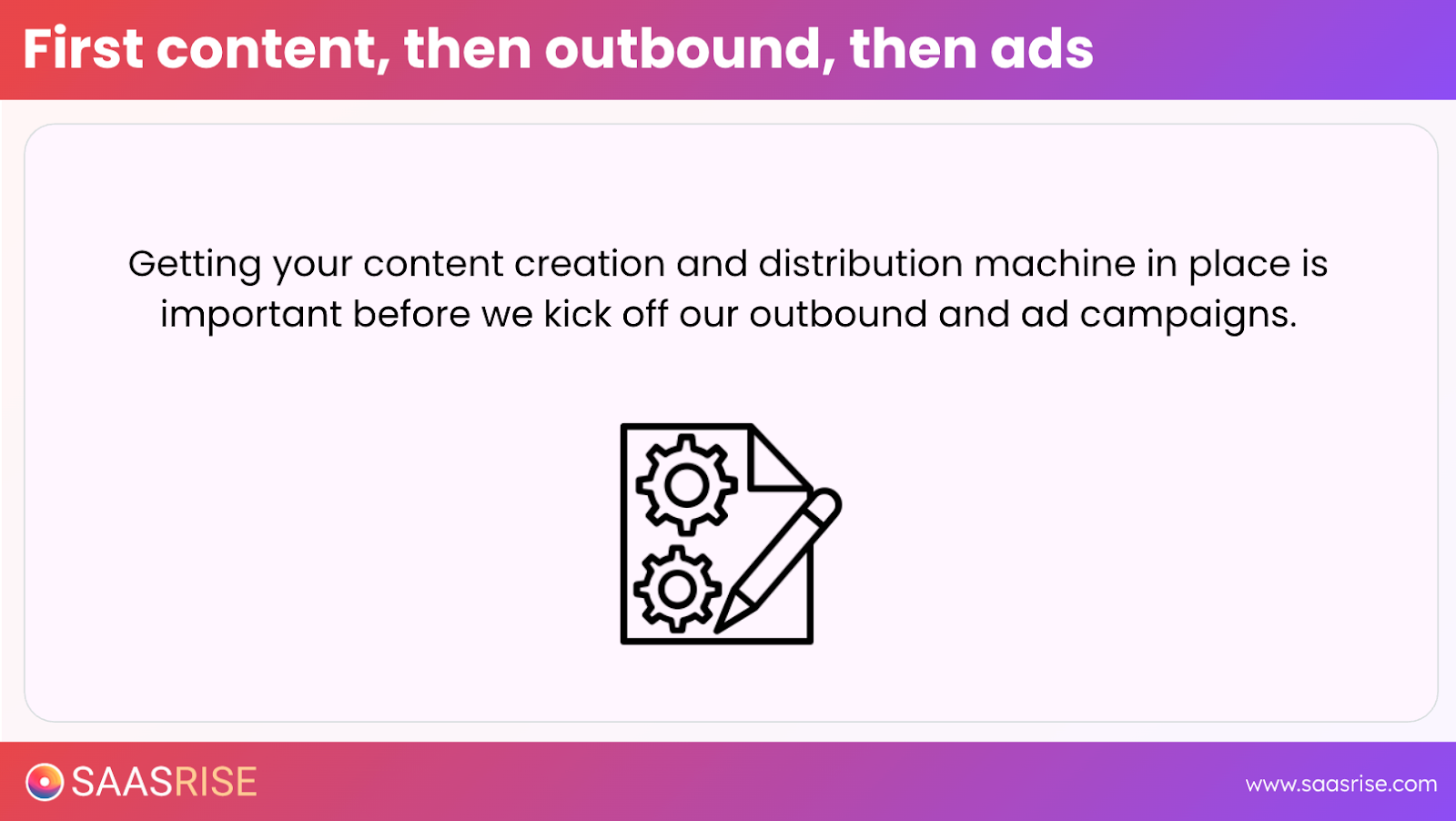
Step 1: Start With a Defined Audience
Before you can build a content machine, you need to know who it’s for. All the great content in the world won’t help if it’s not reaching the right people.
That’s why everything starts with your ABM lead list — the list of people and companies that match your ideal customer profile (ICP). You’ve done the hard work of building that list through tools like Apollo, LinkedIn Sales Navigator, and Clay. Now, it’s time to put it to work.
Your content machine is how you’ll engage that audience over time — through relevant, expert-driven insights that solve their actual business challenges.
Step 2: Measure What Matters — Brand Impressions
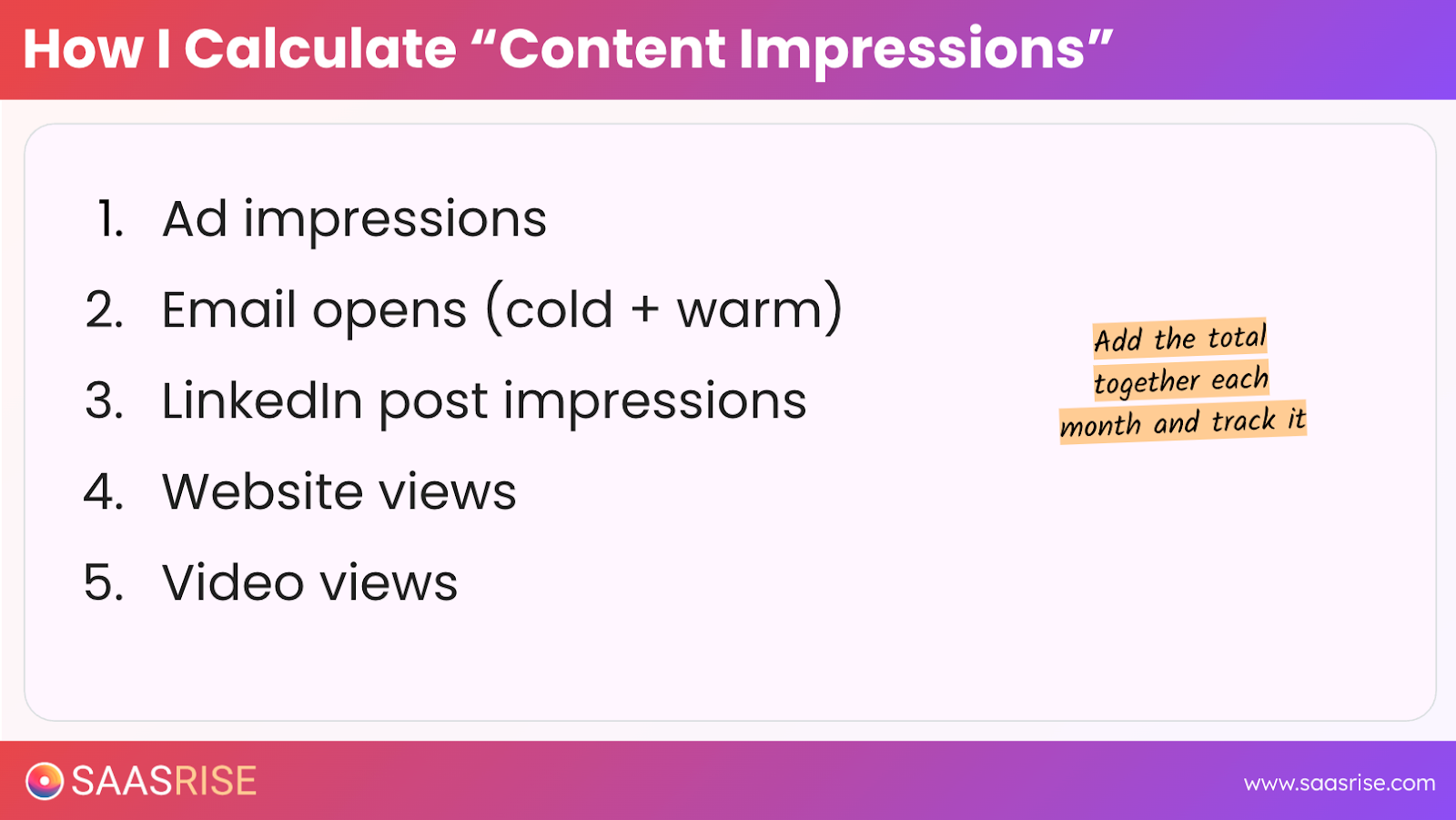
One of the best ways to measure whether your content is working is by tracking impressions — how many times people in your ICP have seen your brand across all channels.
In my experience, companies that reach around 1 million impressions per month inside their niche start to hit real momentum. That’s when you go from being “just another vendor” to being a recognizable brand in your category.
Here’s how to track it:
Core Metrics to Monitor
- Email Opens – Add up opens from both warm and cold emails.
- LinkedIn Impressions – Include organic posts, company posts, and boosted thought leadership ads.
- Ad Impressions – From Meta, LinkedIn, Google, and retargeting.
- Website Sessions – Track visits to your site or landing pages.
- Video Views – On Wistia, YouTube, or wherever you host your video content.
Add them together for your monthly brand impressions.
Most companies start around 50,000–100,000 monthly impressions. The goal is to cross 1 million+, where your brand starts to dominate attention in your space.
Step 3: Commit to One Great Piece of Content Per Week
This is the heartbeat of your system.
Your goal is simple: publish one high-quality piece of content every week.
That’s it.
It can be:
- A case study
- A webinar recording
- A video podcast
- A PDF report or article
- A data-backed thought leadership post
The format doesn’t matter as much as the consistency and quality.

The best-performing companies treat content creation like a meeting that can’t be skipped. Block out 2–3 hours per week to create, review, and distribute new content.
If you do that for six months straight, you’ll never have a “lead drought” again.
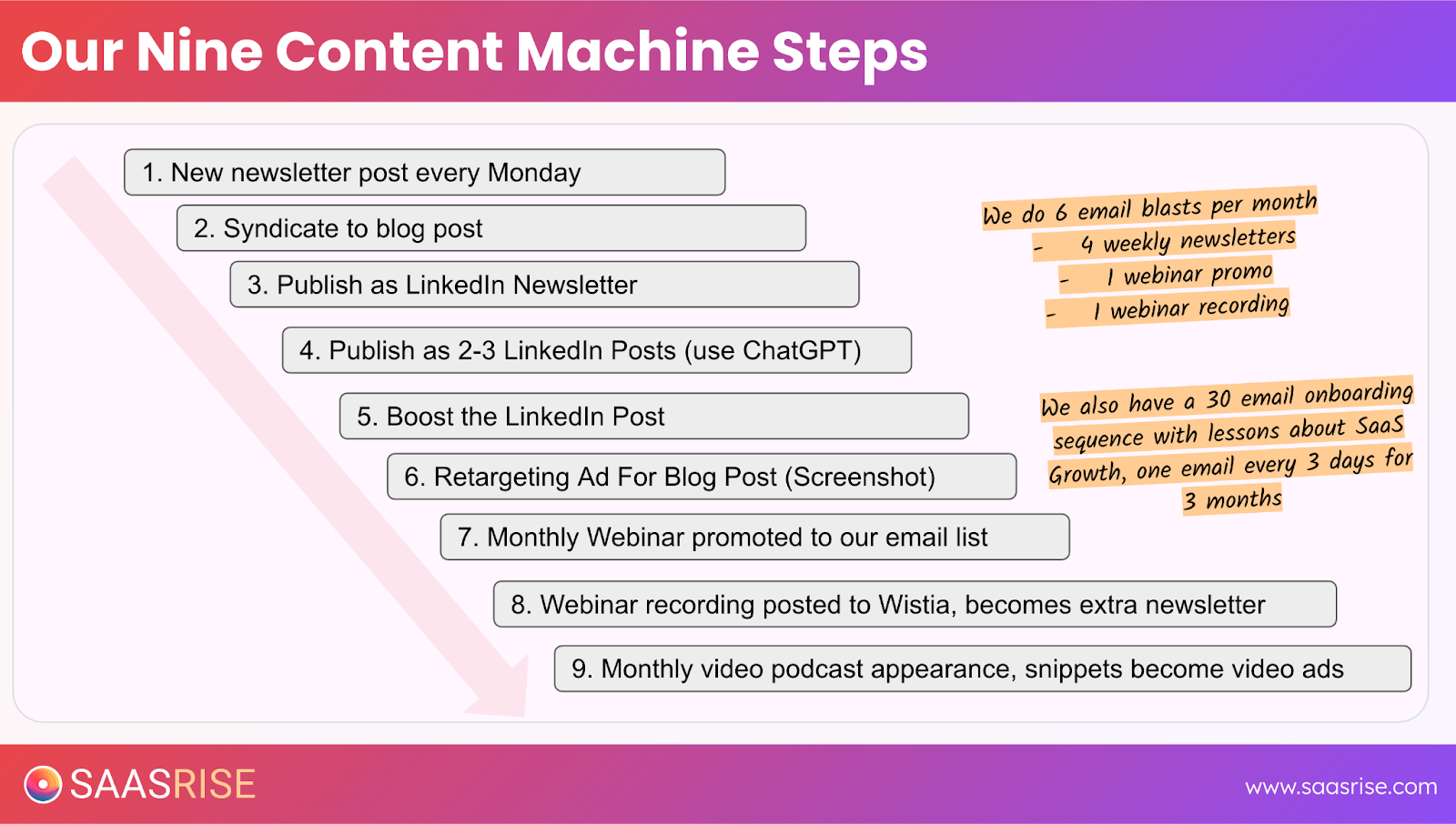
Step 4: Repurpose Your Content Across Multiple Channels
You don’t need to create new content for every platform. You need to repurpose what you already have.
Here’s the workflow I recommend (and use):
- Write one core piece of content each week — a 1,500–2,000-word article or a 10–20-minute video.
- Turn it into multiple assets:
- Email newsletter
- LinkedIn post and/or LinkedIn newsletter
- Blog post for SEO and AEO (Answer Engine Optimization — optimizing for AI tools)
- Retargeting ads using snippets and visuals from your content
- Short video clips for social (LinkedIn, YouTube Shorts, Instagram)
- Send it everywhere your ICP spends time.
Repurposing one flagship piece of content each week means you’re multiplying your reach without multiplying your workload.
Step 5: Write Like a Human (Not a Robot)
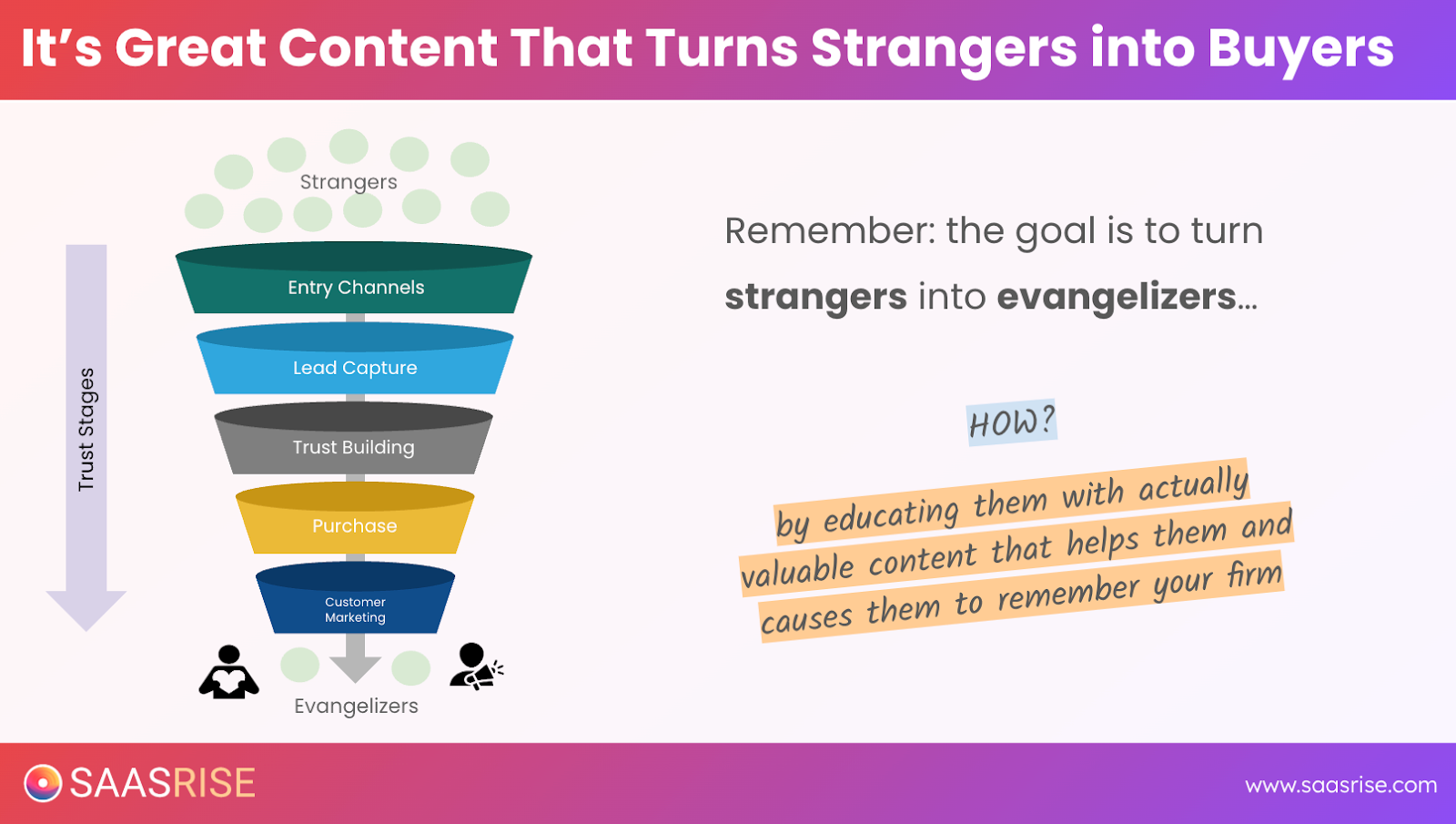
AI is an incredible tool — but it’s not a replacement for real expertise. The best content is written or recorded by someone who truly understands the problem.
If you’re the founder, product expert, or head of marketing, you know the challenges your customers face better than anyone. That’s what your content should reflect.
Here’s the formula:
- You (or your expert) create the raw material — a video, voice memo, or outline.
- AI helps refine it — editing, formatting, summarizing, and structuring.
- A human reviews and finalizes it to ensure quality, nuance, and authenticity.
Use AI as your editor, not your author.
Step 6: Build a Distribution System That Runs Automatically
The key to scaling content isn’t creating more — it’s distributing better.
Once you’ve written your weekly flagship piece, here’s how to make sure it gets seen:
- Email your warm list.
Send your content to your subscribers or leads once per week. Include value first, then a call-to-action. - Publish it on your blog.
Add it to your website for SEO and search visibility. - Post it on LinkedIn.
Share it from a personal account, not your company page. Personal profiles get far more reach. - Boost it with ads.
Run thought leader ads on LinkedIn and Meta targeting your ABM audience. Boosting organic posts is cheaper and often performs better than running separate display ads. - Use it in retargeting.
Turn your latest content into fresh ad creative so your audience always sees something new. - Feed it to your SDR team.
Have your SDRs send valuable content to prospects and leads each week — not just “checking in” messages.
When you combine organic distribution, email, and paid promotion, you get the “surround sound” effect — your target audience can’t go a week without seeing you.
Step 7: Track Performance and Optimize
Every system needs feedback loops.
Once you’ve built your content machine, track how it performs:
- Are open rates and engagement trending up?
- Are impressions growing each month?
- Are more people visiting your site or filling out forms?
- Which content types drive the most replies, leads, or demo requests?
Review these metrics monthly.
And remember — consistency compounds. The companies that stick with weekly publishing for 6–12 months start seeing exponential results.
Step 8: Add Storytelling to Your Strategy
Pure “how-to” content is good — but storytelling is what makes people stop scrolling.
Mix in stories about your journey, your customers, or lessons learned. Show your audience that you’ve been where they are. Educational content builds authority. Storytelling builds connection.
The best brands use both.
Step 9: Build Your Team and Tools Around the System
You don’t have to do this alone.
You can run a world-class content system with a lean team if you set it up right:
- Writer or editor (internal or outsourced) to polish and format your content.
- Virtual assistant or EA to handle publishing, scheduling, and tracking metrics.
- Freelancer or agency for ads and video editing if needed.
Platforms like Athena, Wing Assistant, or Recruit.com make it easy to find trained virtual assistants who can help execute your system for a fraction of the cost of hiring full-time staff.
The point is to build a machine that runs whether or not you feel “inspired” that week.
Step 10: Focus on Value, Not Volume
In a world flooded with generic AI content, quality is your biggest differentiator.
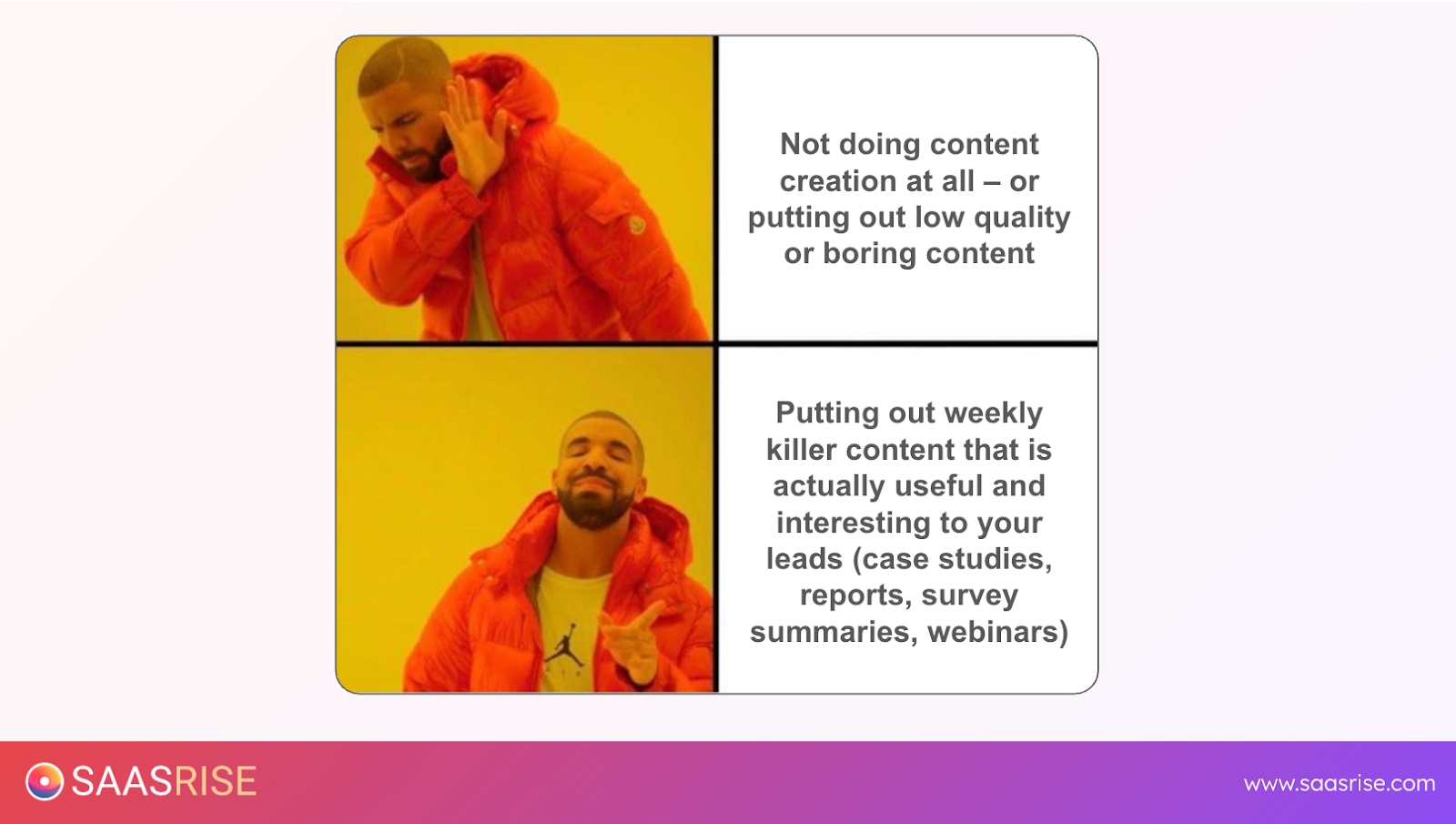
If you put out truly useful, expert-level insights — the kind of content your target audience actually learns from — you’ll stand out instantly.
Your goal isn’t to produce the most content. It’s to produce the most valuable content, consistently.
Educate. Teach. Help.
That’s how strangers become followers, followers become leads, and leads become evangelists for your brand.
The Takeaway
Building a content machine isn’t about posting more. It’s about creating a system that produces value week after week.
Start with a defined audience. Create one great piece of content a week. Repurpose it everywhere. Track your impressions. And keep doing it until your brand becomes impossible to ignore.
You don’t need to be a celebrity or have a massive marketing budget to dominate your niche. You just need consistency, clarity, and commitment.
The companies that build content systems don’t just get more leads — they build authority, trust, and momentum that compounds over time. And that’s how you win in B2B SaaS.
This content is from the 16 week B2B SaaS Growth Program that we run twice a year.

